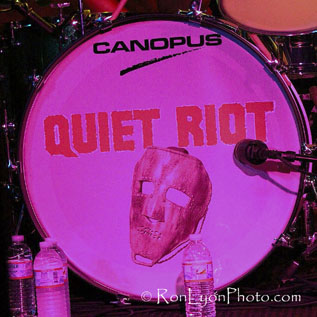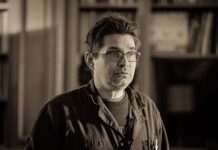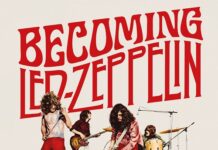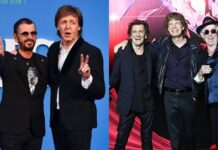Story by Shawn Perry
Photos by Ron Lyon
The trials, trips and tribulations of Quiet Riot are not unlike that of so many bands — a series of incredible highs, cushioned by some equally incredible lows, and a rough ride no matter when or where you were sitting. They were not only pioneers in churning out heavy metal for the pop charts — they also got in on the rise of the MTV music video.
Quiet Riot drummer Frankie Banali recalls those days with great fondness. “We became a staple of MTV because we were fans of the medium,” he said. “It was all so new, so exciting, so visual — and it reached millions in one fell swoop.”
Constant airplay of the videos for “Cum On Feel The Noize” and “Bang Your Head (Metal Health)” helped push Quiet Riot’s first major label release, 1983’s Metal Health, to the top of the mountain, selling 6 million copies in the process.
“While we were aware of the sales and success, we were busy playing shows,” Banali said. “Going From one city to another, one state to another, one country to another, and starting the process all over again — it was exhaustingly fun.”
One memorable event Quiet Riot was part of was the 1983 US Festival. On what was called “Heavy Metal Day,” they opened for six other acts, including Ozzy Osbourne, Scorpions and Van Halen. It was most definitely a highlight in the band’s ascension.
“We had no idea of the size of the event until daylight when we were confronted by over 375,000 screaming fans at 11:30 AM!” Banali said of the US Festival. “The day really was fantastic and we got to see a lot of bands that we loved, especially Judas Priest.”
After Metal Health, Quiet Riot never quite regained their hold on the charts or the hearts and minds of the masses. Some would accuse singer Kevin DuBrow of debilitating their success whenever he talked to the press, but that’s an oversimplification. The dance floor was simply overcrowded in the 80s, and many of the acts swept up in the MTV video blender saw their stars fade quickly. At least, Quiet Riot had the chops to keep it real.
During the course of their rocky 35-year career, Quiet Riot has lost some of its most vital members. There’s Randy Rhoads, who left the band before they got signed, and went on to record and tour with Ozzy Osbourne. Rhoads’ run was cut short when he was tragically killed in 1982 in a senseless plane crash. He was only 25.
More recently, in 2007, DuBrow also met with a senseless end. It was reported that the singer’s last night resulted in an accidental overdose of cocaine. At 52, DuBrow had been to hell and back with Quiet Riot, including being fired from the band in the late 80s. He later reconciled with Banali, guitarist Carlos Cavazo and bassist Chuck Wright, and remained on board for another 14 years.
Like many of their peers, Quiet Riot enjoyed some renewed success in the 2000s — though it was largely nostalgic. They released two studio albums: 2001’s Guilty Pleasures, featuring the Metal Health lineup of DuBrow, Banali, Cavazo and bassist Rudy Sarzo; and 2006’s Rehab, a bit of a departure with a fortuitous title that featured guest players like Glenn Hughes and Tony Franklin.
After that, the band’s future was uncertain. They had become a touring outfit, playing the circuit and keeping the legacy alive. When DuBrow died, it was widely speculated that the group he founded would follow suit. To make it official, Banali issued a statement, saying Quiet Riot was over. “Kevin was too important to go on without him,” he said.
Then Again…
Replacing lead singers, like any pivotal part of the puzzle, can be a risky enterprise. Hardcore classic rock farm boys still scoff at the idea of Lynyrd Skynyrd returning in light of the 1977 plane crash that claimed singer Ronnie Van Zant. And don’t even get me started on Thin Lizzy without Phil Lynott or Yes without Jon Anderson (who’s still alive, by the way).
But isn’t it a strange turn of fate how no one seems to have a problem with Brian Johnson, the man who replaced original AC/DC screecher Bon Scott? Kelly Hansen has also slipped comfortably into the role of Foreigner’s vocalist, while original frontman Lou Gramm continues to pursue a solo career in the Christian music market.
Under just about any set of circumstances, loads of bands with name recognition are doing OK if they can still show up on time and play. Best of all, fans who weren’t around the first time to see their favorite band get a second chance — without having to go the tribute route.
Throwing the dice with the full support of DuBrow’s beloved mother, Banali set out in 2010 to reassemble Quiet Riot. His first calls were to Wright, who’d been in and out of the band since the early 80s (he played on the studio version of “Bang Your Head (Metal Health)”), and Alex Grossi, Quiet Riot’s “road” guitarist since 2004, as well as songwriter on two tracks on Rehab.
When it came to choosing a lead singer, Banali said he wanted someone whose voice would “do justice to Kevin DuBrow, Quiet Riot and the fans.” The drummer acknowledged that DuBrow cannot be replaced, “but,” he said, “I can continue the legacy of Quiet Riot in the best possible and most musically respectful way. The way to do that is by making sure it sounds like Quiet Riot, so the vocals have to be spot on and true to Kevin’s vocal performances…”
The job went to singer Mark Huff, a seasoned pro with Van Halen tribute band 5150. Banali had seen his videos (a popular way of finding musicians these days), and the next thing you know, the stage was set for a Quiet Riot comeback.

After he secured the gig, Huff told the The Dalles Chronicle, “It’s going to be an uphill deal with the fans,” before optimistically adding, “I’ve dreamt of an opportunity like this since I was a teen…”
Wright defended the validity of the reunion when he reminded me that he and Banali have worked together as a rhythm section, on and off, since 1981. If anyone has to weather the storm of critics and naysayers, Banali is probably the easiest target. The drummer, however, makes no apologies for resurrecting Quiet Riot.
“I don’t need to justify it to the critical snipers,” he said. “The only person whose feelings matter to me is Kevin DuBrow’s mother, who I am very close to. She supports it and gave her full blessings. Even my old friend Rudy Sarzo, who isn’t in the band, fully supports my decision to continue Quiet Riot.”
The new Quiet Riot played a couple of warm-up gigs in November 2010 in Tucson and Denver, with an eye out for hitting the road in 2011. They began with a quickie at the end of January in Ramona (just north of San Diego), followed by a three-night bender through three strangely unique Los Angeles area venues: the Brixton in Redondo Beach, the Canyon Club in Agoura Hills, and the Galaxy Theatre in Santa Ana.
When it came to playing the home field, Banali didn’t wince at the potential fireworks. “I really didn’t know what to expect. I knew we would have to play L.A. no matter what, so I jumped into the deep end of the pool early on. I knew, going into it, that there would be true support, true curiosity, true pessimism, true L.A. folding-of-the-arms saying, ‘Show me’ and, of course, ‘Can you put me on the guest list + 30’ requests left and right. We have deep roots in the L.A. music scene, so we had to prove that we really existed here and we did exactly that.”
Beyond the Galaxy
The show I saw at the Galaxy was indeed a glimpse into the L.A. music scene, ala the early 1980s. It was also a rebirth. The power put into the band’s tight-fisted set was enough to make even the stingiest cynic take notice.
The lights dimmed and the opening pre-recorded strains of Queen’s “We Will Rock You” was used to great effect, somehow assuring everyone in the place that Quiet Riot (in the Q’s at the your favorite record store, right next to Queen) was up to the challenge. They came out fighting with “Run From Cover,” the first of eight songs from Metal Health polished up and revisited with Huff front and center.
The crowd surged forth, their fists thrusting up into the musty Galaxy air. Without reservation, the band delivered a solid 90-minute set filled with their greatest songs, mostly from Metal Health, but also four from the follow-up, 1984’s Condition Critical, including a second Slade cover, “Mama Weer All Crazee Now.”
Huff didn’t hit a sour note, at ease filling DuBrow’s shoes and honoring the integrity of the material. Wright, Grossi and Banali churned away, adding wings to the melodies and a thunderous bottom-end to the floorboards. Each would get the solo spotlight for a few minutes, further validating their undiminished musicianship and arena-worthy air of professionalism.
At one point, Banali climbed out from behind his kit and approached the microphone. He spoke reverentially about DuBrow and Rhoads and asked for a moment of silence. “You guys rock,” he said before returning to his drums. The band then fell into “Thunderbird,” a ballad DuBrow had written about Rhoads shortly after the guitarist’s passing.
“Free,” a “newer” song from Rehab co-written by DuBrow and Grossi, is a grungy rocker that reaffirmed the momentum and got the crowd anxious. A rapid succession of high energy QR classics came rolling out — “Breathless, “The Wild And The Young” (from 1986’s QR III), “Let’s Get Crazy” and, as the grand finale, “Cum On Feel The Noize” and “Bang Your Head (Metal Health).” And then…they were gone.
Quiet Riot had conquered Southern California with a grand slam in the OC. The audience was winded, exhilarated, convinced they had seen the real deal. By all accounts and witnesses, they most certainly had.
And So…
There’s a lot on the horizon for Quiet Riot. Banali continues work on a documentary about the band. “So far all of the archival footage has been transferred from the media of its time to digital format going as far back as 1980 and spanning over three decades from my archives,” he said. “Many of the interviews have been done, and there are many, many more ahead that need to be completed. Additional footage is constantly being filmed, including all four California shows. (Independent producer/director) Regina Russell is doing a phenomenal job.”
As for new music from the current lineup, Banali feels Quiet Riot needs to first re-establish itself as a live act before even thinking about writing songs and cutting tracks. “I am in no rush to do anything other than making sure every aspect of the band is in place before seriously considering venturing into the recording studio,” he said.
In the meantime, Quiet Riot’s touring schedule is filling up, with more dates constantly being added. They’ll head east for a few stateside gigs in March before flying overseas to Australia and New Zealand to headline seven shows, with Warrant, LA Guns and various local groups supporting. I asked Banali if there was any possibility of the group going to Europe, and maybe getting in on some of the summer festivals. “There is serious interest from European territories. I am hopeful those will pan out and perhaps festival dates in those markets are in our future too.”
In corresponding with the drummer after the Galaxy show, I mentioned I’d met and chatted with Kevin DuBrow on a couple occasions. The last time was at — where else? — the Galaxy, where he appeared solo, with Wright and Grossi backing him up.
A friend and I went backstage before the show to say hello. As we walked into the dressing room, Steven Adler (also on the bill) was raiding the refrigerator for beer and DuBrow relaxed on the couch. The singer and I started talking, and the next thing I knew, I was getting an education in all things Humble Pie and Spooky Tooth. No question about it: DuBrow was a true disciple of rock and roll.
Banali’s response truly hit home. “One of the many things that I miss about Kevin is our conversations about music and the bands we loved from the 60s and 70s. I miss him each and every day. Rest in peace Kevin. You are missed more than you could ever know. You were a rock star in every sense of the word…”





















